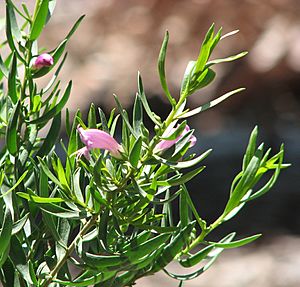Spreading emu bush facts for kids
Quick facts for kids Spreading emu bush |
|
|---|---|
 |
|
| Eremophila divaricata growing in the Geelong Botanic Gardens | |
| Scientific classification | |
| Genus: |
Eremophila (plant)
|
| Species: |
divaricata
|
| Synonyms | |
|
|
The Eremophila divaricata, also known as the spreading emu bush, is a type of flowering plant. It belongs to the figwort family, called Scrophulariaceae. This plant is special because it is only found in Australia, meaning it is endemic there.
It grows as a shrub with stiff, spreading branches that often get tangled. The ends of its branches can be spiky. It has leaves that stand up straight and beautiful flowers that are usually mauve (a light purple) or lilac-coloured.
Contents
What Does the Spreading Emu Bush Look Like?
The spreading emu bush is a shrub that grows between 0.5 and 1.5 metres (about 1.5 to 5 feet) tall. It can spread out to be up to 2 metres (about 6.5 feet) wide. Its branches are stiff and often tangled, and they can end in a sharp spine.
The leaves grow one after another along the branches. They are usually straight, long, and narrow, measuring about 5 to 20 millimetres (0.2 to 0.8 inches) long and 1 to 4 millimetres (0.04 to 0.16 inches) wide. They are usually smooth (which means they are glabrous) and are a mid-green colour.
Flowers and Fruits
The flowers grow one by one where the leaves meet the stem. Each flower has a short stalk, about 1 to 3 millimetres (0.04 to 0.12 inches) long. There are five sepals (leaf-like parts that protect the bud) that overlap and are about 4 to 7.5 millimetres (0.16 to 0.3 inches) long.
The petals are joined together at the bottom to form a tube, and they are about 22 to 28 millimetres (0.87 to 1.1 inches) long. The petals are usually mauve or pinkish-lilac, but sometimes they can be white. Inside the tube, you might see purple spots or streaks. The outside of the flower tube and the petal tips are covered with tiny hairs. The inside of the tips is smooth, but the inside of the tube is full of long, soft hairs. The four stamens (the parts that produce pollen) are completely hidden inside the petal tube.
This plant usually flowers from September to April. After the flowers, it produces oval-shaped fruits with a pointed end. These fruits are hairy and measure about 3.6 to 6 millimetres (0.14 to 0.24 inches) long.
How the Spreading Emu Bush Got Its Name
This plant was first officially described in 1855 by a scientist named Ferdinand von Mueller. He called it Pholidia divaricata. He wrote about it in a book called Definitions of rare or hitherto undescribed Australian plants.
Later, in 1859, Ferdinand von Mueller changed the name to Eremophila divaricata. He published this new name in the Papers and Proceedings of the Royal Society of Tasmania.
In 1992, another scientist, Robert Chinnock, found that there were two slightly different types of this plant, which he called subspecies. Both are now accepted as official names:
- Eremophila divaricata subsp. divaricata: This type has leaves that are smooth or have only a few tiny glandular hairs.
- Eremophila divaricata subsp. callewatta: This type has leaves covered with hairs that look like tiny stars. The name "Callewatta" comes from an Aboriginal name for the Darling River.
The second part of the plant's scientific name, divaricata, comes from a Latin word. It means "spreading at an angle," which describes how the shrub's stiff, tangled branches grow. The name callewatta is from a New South Wales Aboriginal name for the Darling River, where this special subspecies is found.
Where Does the Spreading Emu Bush Grow?
The E. divaricata subsp. divaricata grows in areas that sometimes flood, like the floodplains of the Murray, Paroo, Darling, and lower Murrumbidgee rivers. You can find it in New South Wales, Victoria, Queensland, and South Australia.
It often forms thick, dense groups in heavy clay soils. It grows alongside trees like River Red Gum and Black Box. The subspecies callewatta is only found in one specific spot near Bourke.
Growing Spreading Emu Bush in Your Garden
As its common name suggests, the spreading emu bush has branches that arch outwards, sometimes even touching the ground. It's a very strong and tough plant. It doesn't get sick easily, but kangaroos do like to eat it! Even if it's heavily pruned or eaten, the shrub can usually grow back well.
It's quite easy to grow new plants from cuttings (small pieces of the plant). It can grow in many different types of soil, even heavy clay. Because it naturally grows in places that have long dry periods followed by floods, it can handle both very dry spells and occasional wet conditions. It can also survive very cold frosts.

